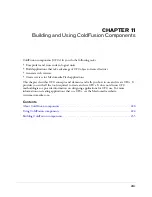
Using ColdFusion components
229
Passing parameters using the cfinvokeargument tag
To pass parameters in the
cfinvoke
tag body, use the
cfinvokeargument
tag. Using the
cfinvokeargument
tag, for example, you can build conditional processing that passes a different
parameter based on user input.
The following example invokes the corpQuery component:
<cfinvoke component="corpQuery" method="getEmp">
<cfinvokeargument name="lastName" value="Wilder">
</cfinvoke>
The
cfinvokeargument
tag passes the
lastName
parameter to the component method.
Invoking methods using dynamic method names
The
cfinvoke
tag is the only way to efficiently invoke different component methods based on
variable data; for example, form input. In this case, you use a variable name, such as
Form.method, as the value of the
method
attribute, as the following example shows:
<cfinvoke component="corpQuery" method="#Form.queryType#">
Using components directly in CFScript and CFML
You can invoke methods of a component instance directly using CFScript or in CFML tags. After
you instantiate a component, you can invoke the component methods any place that you can use
ColdFusion functions.
You can also access data in the component’s This scope directly in CFScript and
cfset
assignment statements. For example, if a User data CFC has a This.lastUpdated property, you
could have code such as the following:
<cfobject name="userDataCFC" component="userData">
<cfif DateDiff("d", userDataCFC.lastUpdated, Now()) GT 30>
<!--- code to deal with older data here --->
</cfif>
For more information, see
“The This scope” on page 242
.
Invoking component methods directly
To invoke component methods directly, use the
CreateObject
function or
cfobject
tag to
instantiate the component. Thereafter, use the instance name followed by a period and the
method you are calling to invoke an instance methods. You must always use parentheses after the
method name, even if the method does not take any parameters.
You can use this syntax anywhere that you can use a ColdFusion function, such as in
cfset
tags
or surrounded by pound (#) signs in the body of a
cfoutput
tag.
Invoking component methods in CFScript
The following example shows how to invoke component methods in CFScript:
<!--- instantiate once and reuse the instance--->
<cfscript>
tellTimeCFC=createObject("component","tellTime");
writeOutput("Server's Local Time: " & tellTimeCFC.getLocalTime());
writeOutput("<br> Calculated UTC Time: " & tellTimeCFC.getUTCTime());
</cfscript>
Summary of Contents for ColdFusion MX
Page 1: ...Developing ColdFusion MX Applications...
Page 22: ...22 Contents...
Page 38: ......
Page 52: ...52 Chapter 2 Elements of CFML...
Page 162: ......
Page 218: ...218 Chapter 10 Writing and Calling User Defined Functions...
Page 250: ...250 Chapter 11 Building and Using ColdFusion Components...
Page 264: ...264 Chapter 12 Building Custom CFXAPI Tags...
Page 266: ......
Page 314: ...314 Chapter 14 Handling Errors...
Page 344: ...344 Chapter 15 Using Persistent Data and Locking...
Page 349: ...About user security 349...
Page 357: ...Security scenarios 357...
Page 370: ...370 Chapter 16 Securing Applications...
Page 388: ...388 Chapter 17 Developing Globalized Applications...
Page 408: ...408 Chapter 18 Debugging and Troubleshooting Applications...
Page 410: ......
Page 426: ...426 Chapter 19 Introduction to Databases and SQL...
Page 476: ...476 Chapter 22 Using Query of Queries...
Page 534: ...534 Chapter 24 Building a Search Interface...
Page 556: ...556 Chapter 25 Using Verity Search Expressions...
Page 558: ......
Page 582: ...582 Chapter 26 Retrieving and Formatting Data...
Page 668: ......
Page 734: ...734 Chapter 32 Using Web Services...
Page 760: ...760 Chapter 33 Integrating J2EE and Java Elements in CFML Applications...
Page 786: ...786 Chapter 34 Integrating COM and CORBA Objects in CFML Applications...
Page 788: ......
















































